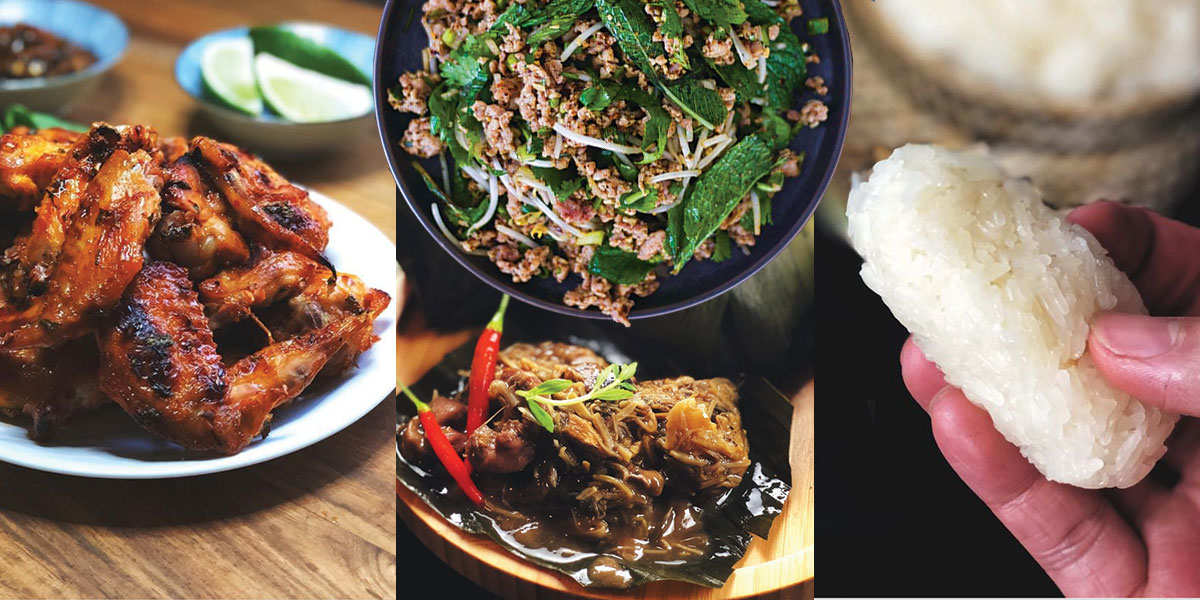9 Essential Lao Dishes To Acquaint Yourself In The Rich Cuisine

Editor’s Note: Lao Chef, Saengthong Douangdara was a recent guest on Foodbeast’s ‘The Katchup’ podcast to discuss all things Lao food. Listen to the episode here.

It can be confusing sometimes when you enter a Southeast Asian restaurant because you may have run into some dishes you didn’t know originated from Laos. This is especially common with Thai restaurants.
This is because when Lao people came to the U.S. as refugees of the Vietnam War starting in 1975, the Lao people that opened restaurants started creating Thai restaurants with Thai food and Lao dishes sprinkled throughout the menu. That’s because Thai food was the easiest way for Lao people to gain leverage in the U.S. since many Westerners loved and knew about Thai cuisine already. As a result, customers of these restaurants started getting these foods confused. But these days, thanks to a growing awareness, a Lao food movement is helping Laotians feel empowered about their food.
Lao food is very spicy, pungent, fermented, fresh, and features an aggressive amount of flavors. Some important ingredients to make Lao food are: padaek (unfiltered fish sauce), sticky rice, galangal, lime leaves, lemongrass, green onions, cilantro, and mint. Many foods are fermented with sticky rice like som pak (fermented mustard greens); it is similar to kimchi without the vibrant red colors.
Let’s break down the signature nine essential dishes that make up Lao cuisine so you can feel confident in looking for and trying them!
Khao Niew
Lao people are called “luuk khao niew” which means “children of sticky rice.” Sticky rice is a staple in Lao meals and is eaten 24/7, whether it’s for breakfast, lunch or dinner. It is used as a utensil when eating various minced meat dishes or dipping it into spicy dips.
Laab
Laab is the unofficial dish of Laos, and it is made from any minced meat mixed with lots of herbs and padaek (unfiltered fish sauce). Many Lao dishes are served spicy, and it includes this dish. One of the unique flavors from this dish comes from the roasted sticky rice powder which gives it a toasted, nutty flavor.
Thummakhoong
It is not a Lao meal without thummakhoong Lao papaya salad on the table. With every crunch of the papaya, it comes bursting with funk, spice, and saltiness. Although it may look dark and smell pungent, it blasts with umami flavors when eaten with sticky rice.
Khao Piek Sen
Khao piek sen is the upgraded spicy chicken noodle soup. It’s perfect for a cold evening with the chewy tapioca rice noodles sitting in a garlicky chicken broth. It is perfectly garnished with fresh cilantro, green onion, and lime.
Gaeng Nor Mai
Gaeng nor mai is the jungle stew of Laos. Staring at the stew, it is a murky green with dark shades of veggies. It is filled with earthy flavors from bamboo, yanang leaves, and rice paddy herbs. Sticky rice paste mixed with fresh bird eye chilies are used to thicken the stew.
Jeaw Mak Len
It may not be an entree, but jeaw mak len is an essential dip made from roasted bird eye chilies, cherry tomatoes, shallots, and padaek. It shines with the vibrant red color with every dip of sticky rice and is usually eaten with a meat dish.
Mok
Any mok dish in Lao cuisine is a form of steaming a bundle of goodness within banana leaves. The bundle is filled with crushed uncooked sticky rice, bird eye chili peppers, lemongrass, shallots, padaek, lime leaves, and green onions. It is the perfect dish to eat with sticky rice as the mok is usually thick and filled with bamboo or fish. A popular mok is mok pa catfish, since catfish is highly prized in Southeast Asia.
Bing Gai
Bing gai can be found all over the streets of Laos. It is grilled chicken usually marinated in fish sauce and oyster sauce. This common street food pairs perfectly with sticky rice and a spicy dip like the one mentioned above, jeaw mak len. The chicken is sometimes even grilled with a coating of peppers.
Sai Oua
Sai oua is Lao sausage. It is filled with fatty pieces of pork surrounded by aromatics like lemongrass, lime leaves, galangal, shallots, and cilantro. The sausage can be soured for a few days and you can find different variations of Lao sausage in various regions. It is soured when cooked with sticky rice, which acts as the carbohydrates in the fermentation process.






















